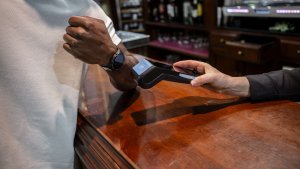Wearable Payments: A Hype Or A Reality?
Smart payments is an industry on the move, how can small businesses keep pace with the market?

It’s 2018 and contactless transactions are more or less the standard. In fact consumers no longer just use cards for touchpoints and terminals, the likes of Apple Pay and Android Pay are also gaining huge traction.
This raises the question, does the future of in-store transactions include cards at all? Already we are seeing wearable payments growing in importance and this should be a clear sign that retailers must consider the implications these emerging technologies hold for the future.
So what does the landscape look like for business owners right now?
The ‘emerging tech’
Wearable payments gained a significant amount of attention at the start of 2017. Some businesses made huge strides in this space and many analysts speculated about the future applications of the technology. One such business was prestigious Swiss watchmaker, Movado, which announced a line of watches called Movado Connect, functioning through Google’s Android Wear 2.0 platform.
The Movado Connect offered countless apps, including basic notification and fitness-tracking features but also Android Pay. This was certainly a groundbreaking watch for Movado but it was by no means making wearable payments widely accessible for the mass market.
In more recent examples, Visa has struck deals with the National Bank of Greece and CaixaBank to enable customers to make transactions through their jewellery and watches. The card giant is also teaming up with the likes of Garmin and Links of London to develop a solution that will bring consumers a simple and secure purchasing experience.
These deals were announced after research from Mastercard, suggested that one-quarter of Europeans expect to start using tap-and-go payments with a smartwatch, bracelet, keyring or other wearables. So where does this progress leave small business owners?
What Does This Mean For You?
The prospect of accepting wearable payments may seem daunting and complex, but businesses should consider the credibility of these emerging technologies. Wearable payments is not a passing fad. More wearable devices are gaining payment functionality, and it’s expected that this will see a huge increase in use by 2020.
Some forecasts suggest that wearable payments will become a $501.1 billion market by 2020 and recent statistics from Barclaycard claim that ‘touch-and-go’ payment options have grown by 129% over the last 12 months. This huge growth is expected to be a major catalyst for mass adoption in the future.
Many customers are starting out their journey in wearable payments thanks to multi-function devices. In many ways, wearables are the perfect outlet to embed contactless payments and therefore seem a logical next step in the payments industry. In the near future, we’re expecting to see products like smartwatches with pre-existing payment apps increase in popularity.
Preparing for Wearable Payments
Wearable payments might not be a priority for all businesses, but there are certain actions to take in order to be prepared for the rising influence of the emerging tech. Small businesses, retailers in particular, must stay ahead of the competition in order to meet the demands of the digital consumer.
Many people don’t care if you are a multinational enterprise or a local business employing five people - they expect great service on-demand. It is therefore crucial that retailers open up to accepting contactless payments from wearable devices. In the current climate, consumers expect a range of payment methods when they come to the end of their in-store experience.
In the future, retailers planning to incorporate a wearable payment facility need to consider how it will feed into their entire customer experience. Delivering a disappointing payment option at the end of a great experience, can still be a fatal blow for a business.
If small businesses are to gain a critical advantage in their marketplace, giving people the seamless payment options that they have come to expect will be essential. Such changes give businesses the chance to punch above their weight and ensure that every aspect of the customer experience is optimised.
It’s the responsibility of the business to make sure it is prepared for the emerging tech coming on the horizon. Customers certainly aren’t going to wait for them to get their house in order.
David Maisey is founder and managing director of Chip & PIN Solutions, a Valitor company.
Thanks for signing up to Minutehack alerts.
Brilliant editorials heading your way soon.
Okay, Thanks!

